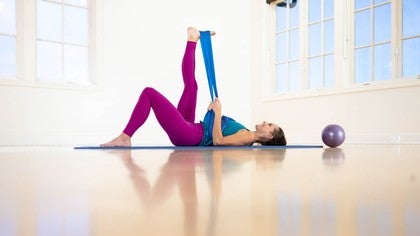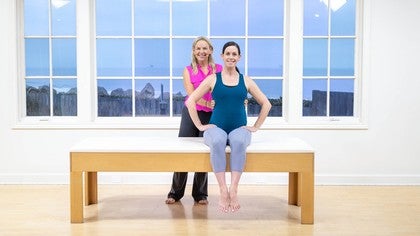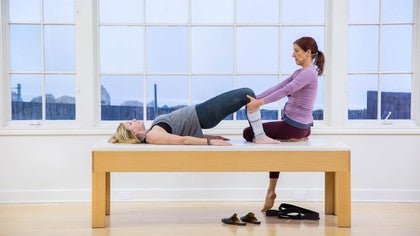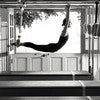Description
About This Video
Transcript
Read Full Transcript
Hi. Today, we're gonna talk a little bit about arthritis and using Pilates, specifically Pilates on the mat for this moment, ways that you can help people who suffer from that condition. So arthritis in a nutshell is a general term for inflammation of the joints. And the 4 most common joints that are affected are the knees, hips, hands, and spine. So you might think of the spine, not like a joint, but the spinal segments each spinal segment, which articulate on one another, each is its own small joints. There's a number of different reasons why Pilates specific is an excellent form of exercise for those who suffer from arthritis. The first is its low impact nature. Because of the low impact nature of Pilates, it's very gentle and good for people who are experiencing pain in their joints because we can provide support and we can provide gentle exercises.
So we're not doing very strenuous joint loading or high impact activity. Another thing is that Pilates focuses on elongating the musculature and flexibility in the joints is very important for people who suffer from pain in their joints. In addition to the flexibility component, Another important thing that we can get by practicing Pilates is strength in our muscles. So We are very mindful as we're doing Pilates that we are working very specifically in, Organizing our bodies in a certain way and being very specific about how and when and which muscles to contract. And so in that way, we can strengthen the muscles that surround the joints in the body.
And help the body suffer overall from less discomfort. In addition, Pilates teaches body awareness which is valuable for anyone, but specifically for people who suffer from pain because it helps them understand where their body is in space and how they might be able to more optimally align themselves or work away from habitual movement patterns that may be creating more discomfort. So we can use Pilates both for pain management and also to help develop strength and flexibility in the body all in an effort to reduce pain. So what I'm gonna do today is I'm gonna show you a few or just give you some ideas of Matt Pilates exercises that you could offer to someone who might be looking to de crease pain in their body. And what we're gonna really be focusing on are exercises that primarily focus on mobilizing the joints in the body and providing some support towards flexibility.
And then a couple that will also, gear more towards the strength of the muscles. So as I go through each movement, I will demonstrate for you first and also explain a little bit about why that could potentially be a valuable exercise choice. The first exercise that we're gonna look at is just very simple pelvic tilts. When you're doing a pelvic tilt, you need to be lying down. So I'll lie down.
I have a couple of things here. I have a dynaband and just a small ball just to offer a couple more suggestions. So very, very simple exercise. The pelvic tilt First, we wanna get the spine organized, so it's in a neutral alignment. So neutral alignment means the head is down. The hail bone is down, the ribs are down.
And what you'll, find is that there's a little bit of a lumbar curvature, natural lumbar curvature that happens when the neutral natural curves of the spine are present. So in a pelvic tilt, we would just draw the abdominals in and allow the lower spine to flatten And then return back. So we can use our breath and on inhale to prepare and an exhale to draw the abdominal muscles downwards and use the front of the body to imprint the back of the body into the floor and inhale to return back to that neutral spine. So the value in this exercise, I'll do one more. Is that it helps to mobilize both the hip joints and also the lumbar spine just creating a little movement in that those places where people can sometimes feel a little stuck.
Another exercise that's valuable is just a simple leg slide. So these are all very fundamental movement patterns. What we'll do here is we'll slide one leg out along the mat. So sometimes it the mat gets a little sticky. So it might be nice to do on a grant on the floor or easier with socks on. So we just take the leg out, mobilizing the knee joint and the hip joint. And then we, again, from the center of the body, the abdominal muscles feel that we're pulling the leg back into the bent position. The inhale breath will take the leg away So the hip elongates the knee joint gets to become straight. We're gently strengthening the muscles of the knee and the hip without pushing too much into, force or impact.
I'll do a couple on the other side reaching out Now one part of the body is moving, and the rest of the body has to stabilize. So that's the body awareness piece. Can I move the hip joint and the knee joint without letting any other piece of my body be affected? So as I'm sliding my leg, I'm not letting my pelvis tip or side to side lean. It seems like it would be really, really easy to do, but it's actually, not core it's more difficult than you might imagine. And if you try it and really focus on keeping everything else still, you will likely feel the difficulty in that movement pattern.
So for the next couple of exercises, we're gonna take advantage of the props that we have here. We have a small ball and also a theraband, as I mentioned before. I'm gonna put them close by me so I don't have to come up again. We the one thing the ball is nice for now, there's many, many different opportunities to use these props. In a variety of ways, but I'll just show you 1 or 2 things. The reason I have the ball here is because we're gonna use it to support the head for some core activation. So elevating the head and chest allows us to bring the upper body more towards flection, and it also gives someone just some stability under the back of their head so they're not having to strain their neck.
We're gonna lift the or left leg and the left hand. So what I want us to do is push with the arm forward onto the leg and at the same time, pull the leg back and draw the abdominals in and also keep the neutral pelvis. Again, another exercise that looks like it shouldn't feel like anything, but it can actually be quite difficult. Release and draw the abdominals in, press the leg into the hand and the hand into the leg. Without changing the alignment of the spine.
And we'll do a couple on the other side. So the leg comes up. The spine stays in that neutral alignment except for the head, which is lifted and supported by the ball. You could also do this with your all the way down on the ground or on a pillow. So we do right hand, right thigh, and we feel that as the leg is pressing back against the hand, and the hand is pressing into the thigh in opposition that we're just trying to generate some strength of the abdominal muscles.
And then you just release and you do it again. Press exhale. Keep the pelvis in neutral or the tailbone down. It was things mean the same to me and release. Another very valuable exercise for people with arthritis are leg circles. So leg circles can be done a couple of different ways. One would be to just bring the leg up without any support.
You could have a fully straight leg or a soft knee, depending on someone's flexibility. So done without a theraband, a leg circle will help to strengthen the muscles of the hip. And also work to create a challenge for, spinal stabilization. So it's just a mobility exercise letting the femur roll around in the hip hip socket. So that is more of your size and you allowed someone to put their leg into a Sarah band.
It becomes much more of a flexibility focus. Not everyone will be able to get their leg all the way up to straighten via to keep the pelvis organized the way we want it. So again, a soft knee is an option or just taking the legs slightly further away from the body. And here, when we have the Therabant for support, we do the same movement pattern, but it's much less difficult for the hip muscles and more just allowing for freedom in the hip joint. So working on hip mobility, the lengthening of the muscles in the back of the leg and also spinal stability. The next thing we're gonna look at is some back extensions, some gentle back extensions, so we'll need to just turn all the way over The arms will reach out in front of us, the legs will reach out behind.
So this is a preparation exercise for a preparation exercise for an exercise that's actually much more difficult called swimming, but what we'll do is we'll let the arms support our upper body And then we'll take one leg and the opposite arm away from the ground. So once again, as with all of the other movements that we've spoke about, spinal stability and awareness of stability will be key alternating sides. So the value in this exercise is that we're bilaterally strengthening our spinal extensors We're working on mobility of the shoulders and hips and stability of the trunk. So I'm not lifting the very high. I'm thinking more of reaching my arm and my leg of length thinning out from the center of my body and down.
Always nice after working the back muscles to take the body up and into a counter stretch. So you could round back if people have pain in their knees sitting all the way down towards their feet might not be available. If people have healthy knees, this can be quite a comfortable position. You can also do open knees and allow the hips a little bit more freedom. If people experience pain in their knees, you can just come back to the point in which there is no discomfort and just rounding the spine.
And lastly, One more spinal mobility exercise. So we come into a 4 point kneeling position The hands will be directly under the shoulders and the knees will be directly under the pelvis. And we're gonna do a cat stretch. So we tuck the pelvis under. So same thing we did in the pelvic tilt.
We're gonna let the spine around. And as you're rounding your spine, you wanna think of the center of the body or the abdominal muscles helping you create that shape. And then we elongate the body back to a straight line, and then we can arch the spine. So the low back arches, the upper back arches, very gentle movement. Come back to straight.
It's useful to feel the arms pressing down, the knees pressing down, the arms and the legs pulling towards one another just actively, something that you'll see, but something that you'll certainly feel if you try. And then coming back, So here, we're just creating awareness of how to recruit the muscles in the center of the body, and we're also focusing on finding some mobility in all of the different parts of the spine. So lumbar flexion, thoracic flexion, and then gentle extension. So those are just a few ideas of how you might start working with someone who experiences arthritis And a couple of things to note is is it's very important to start small with gentle exercises and then gradually in prove the level of difficulty or gradually challenge the level of difficulty over time. And, also, it's important for your client or yourself or your student to really listen to their body and not push themselves into any movement that causes discomfort or pain.
So I hope that was helpful. See you again soon.
Tips for Teachers: Working with Contraindications
Comments

You need to be a subscriber to post a comment.
Please Log In or Create an Account to start your free trial.












